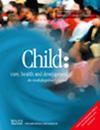Impact of Smartphone and Device Usage in Children Between 18- and 60-Months Old on the Development of Social Communication: Observational and Cross-Sectional Approaches in Kolkata, West Bengal, India
Abstract
Objective
The rapidly increasing use of smartphones/other devices has raised significant concern for parents, clinicians and teachers, especially during and after the global pandemic situation. The study hypothesized that children between the ages of 18 and 60 months might have delayed communication development compared to those in the same age group who did not have any delays because of excessive screen time and the types of content they usually view on their smartphones/other electronic devices.
Method
507 (Group A) children with communication delays and 388 (Group B) children without delays, both boys and girls, aged 18 to 60 months, were included in this observational and cross-sectional study. The developmental milestone of social communication was evaluated using the Bayley scale. Smartphone/other electronic device viewing variables among participants were interviewed. The odds ratio established whether screen time and content typically viewed influence delayed social communication development or not.
Result
In Group A, 71% of children used smartphones or other electronic devices. Group A and Group B had significantly different scores on the Bayley scale, with a p-value of < 0.005. With a p-value of < 0.005, the content that children accessed on their smartphones and other electronic devices was statistically significantly linked to delayed communication.
Conclusion
Our research stated that screen time and content that is typically viewed may be a contributing factor; it is not the sole cause of communication delays because other aspects of a child's environment, including the number of caregivers, the length of time spent with parent–child interaction, the scope of social interaction and the scope of outdoor activities, play a significant role in frequent activities on smartphones/other electronic devices.

 求助内容:
求助内容: 应助结果提醒方式:
应助结果提醒方式:


